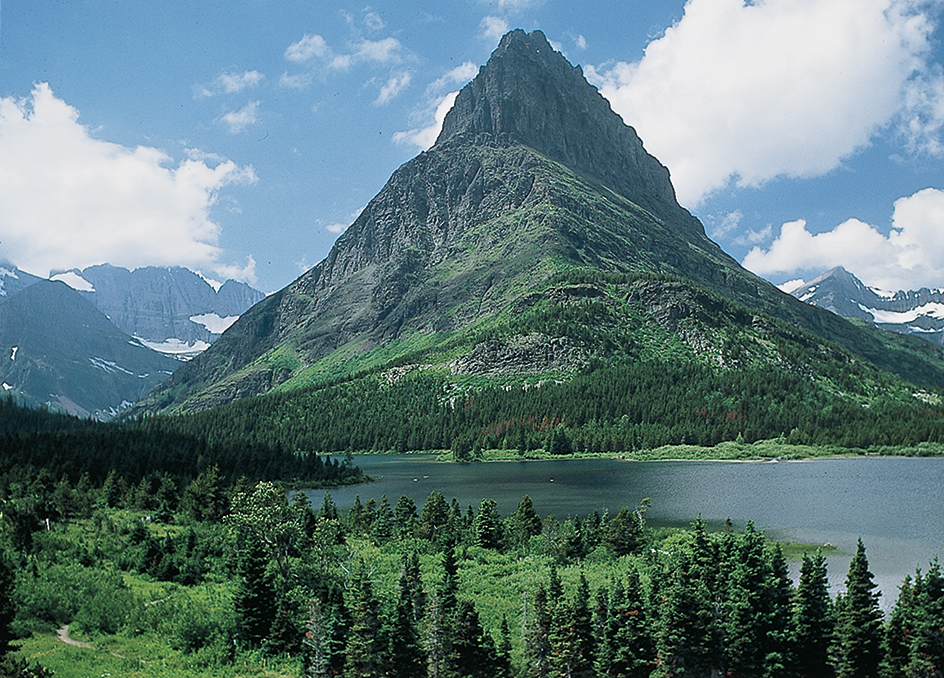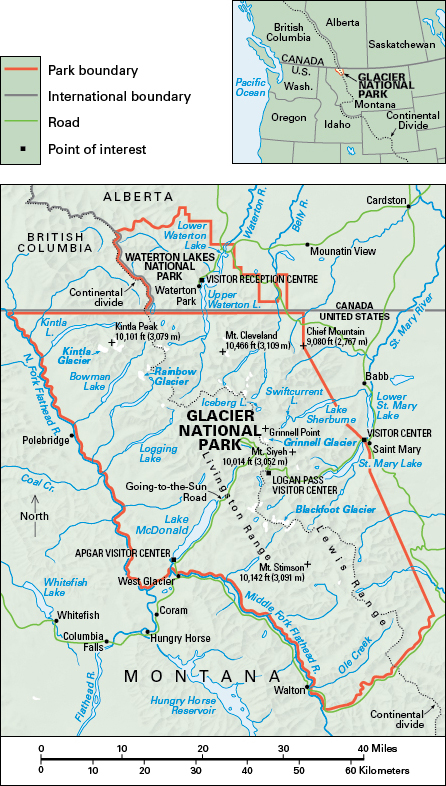Glacier National Park lies in northwestern Montana on the boundary between the United States and Canada. The park was established in 1910. Its eastern half was once part of the Blackfeet Indian Reservation. A Canadian preserve, Waterton Lakes National Park, lies north of Glacier National Park. In 1932, the two parks were united by the U.S. and Canadian governments. Together they are called the Waterton-Glacier International Peace Park, but they are under separate administrations. For the area of Glacier National Park, see National Park System (table: National parks).

Glaciers.
The park was named for the large number of glaciers found there. These beds of ice are the remains of a large system of mountain glaciers that once covered the entire area. In 1850, the area had about 150 glaciers. By the 2020’s, fewer than 30 glaciers remained. Nearly all scientists attributed the reduction in glacial area to global warming, an increase in the average temperature of Earth’s surface since the mid-1800’s. Global warming may have been caused mostly by human activity. The scientists predicted that, should climate trends continue, the park could have no glaciers by the year 2100. Large glaciers remaining in the park today include the Grinnell and Blackfoot glaciers.

Mountains.
Glacier National Park is also noted for its beautiful mountains, whose peaks form picturelike designs. The summits of some of these mountains have never been reached by climbers. The highest peak in the area is Mount Cleveland (10,466 feet, or 3,190 meters), which lies in the northern part of the park. Other mountains higher than 10,000 feet (3,000 meters) include Kintla Peak, Mount Siyeh, and Mount Stimson.
Lewis Overthrust
is a high ridge visited by thousands of tourists. Colorful layers of rock may be seen along the sides of the ridge, much like the layers found in the Grand Canyon of Arizona. This overthrust was made in ancient times when a disturbance inside Earth caused Earth’s surface to crack. One area was pushed, or thrust, up and over another area.
Lakes.
The park has about 250 lakes. Some lie high in the mountains, and others nestle deep in the valleys. One of the most beautiful of these lakes is St. Mary Lake. It is about 10 miles (16 kilometers) long and is surrounded by mountains, except at the point where it meets the St. Mary River. Lake McDonald, the largest in the park, measures 10 miles (16 kilometers) long and has an average width of 11/4 miles (2 kilometers). Swiftcurrent Lake, one of the smallest lakes in the park, is also one of the most famous because it lies in a region of great beauty. Iceberg Lake, only 1/2 mile (0.8 kilometer) long, lies on such high ground (6,000 feet, or 1,800 meters) that it contains icebergs even in summer.
Animal life
in Glacier National Park is protected by law, and hunting is never allowed. Among the wildlife found there are Rocky Mountain goat and sheep, bear, moose, elk, deer, coyote, wolves, and lynx. Game birds, such as geese and ducks, nest in the park. The streams are abundant with fish, especially cutthroat trout. Eastern brook trout and mountain whitefish are also found in the streams.
